A Gentle Introduction to using Support Vector Machines for Classification
Support vector machines (SVM) are remarkable for the unification of geometric theory, elegant mathematics, theoretical guarantees with strong practical use cases. In this blog post, I demonstrate certain properties of SVM and how to use them with caret package in R.
October 2, 2022
Date
October 2, 2022
Time
11:30 AM
Location
University of Tennessee
Event
TA Guest Lecture
What are Support Vector Machines (SVM)?
Support vector machines are supervised learning models that analyse data to find patterns useful in classification and regression. They are versatile: they can identify non-linear relationships, work with discrete and continuous data, and are used for two-class classification, multi-class classification as well as regression. They are remarkable for unifying geometric theory, elegant mathematics, and theoretical guarantees with practical solid use cases.
They provide several specific benefits.
-
With the use of Kernel functions, they are highly effective in higher dimensional spaces.
-
When the number of dimensions is larger than the number of samples, SVM can still be used. However, one has to be careful with the chosen regularisation parameter ($C$ in this article) and the Kernel function.
-
Only a subset of training data (called support vector) is used for prediction. Therefore, retaining all the training information in the memory is unnecessary, so the prediction process doesn’t slow.
History
Vladimir Vapnik and colleagues developed the theory for SVM at AT&T Bell Laboratories1 in 1963. They are one of the most robust prediction methods based on a statistical learning framework called VC Theory developed by Vapnik and Chervonenkis.
Properties of SVM with soft-margin are examples of empirical risk minimization (ERM) algorithm with hinge loss function. SVMs belong to a natural class of algorithms for statistical inference, which also happens to produce really good predictions.
Inference + Prediction = Data Science. What more can you ask?
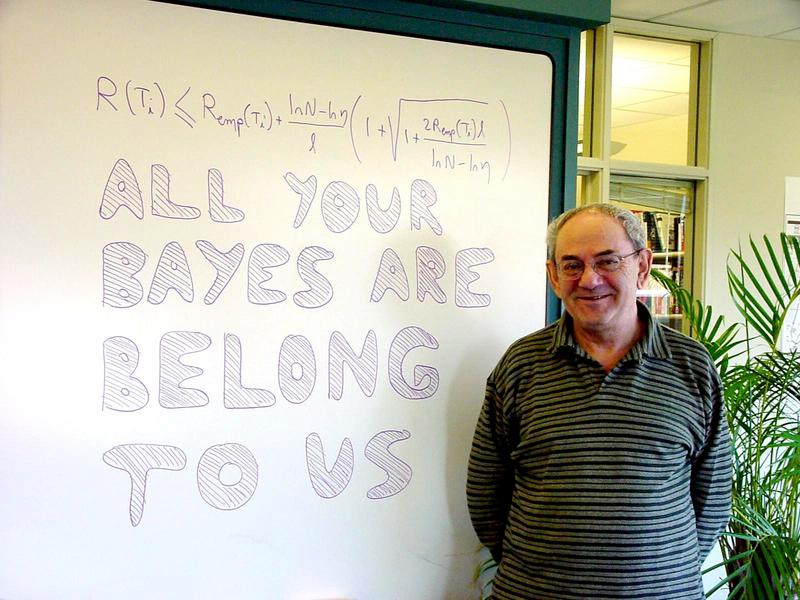
Vapnik showing off his ERM framework, taking a jibe on superiority to Bayesian statistics. (ERM formula at top.)
How do they work?
Geometrically, SVM tries to find a linear hyperplane that separates the data into two classes.
Consider the following example where I’m selecting two species of Iris flowers and plotting their sepal width and sepal length. The colour represents the species.
library(tidyverse)
theme_set(ggthemes::theme_clean())
p = iris |>
filter(Species != "versicolor") |>
ggplot(aes(x = Sepal.Length, y = Sepal.Width, colour = Species)) +
geom_point()
p

There seems to be a clear separation between the two species. Can we draw a (straight) line that separates them?
p = p +
geom_segment(aes(x = 4, y = 2, xend = 7, yend = 4.5),
colour = 4, lty = 2, alpha = 0.7)
p

Except for one setosa which is misclassified, we got them all right.
However, there are infinitely many other lines possible.
p = p +
geom_segment(aes(x = 4.4, y = 2, xend = 6.5, yend = 4.5),
colour = 5, lty = 2, alpha = 0.7) +
geom_segment(aes(x = 5, y = 2, xend = 6.5, yend = 4),
colour = 6, lty = 2, alpha = 0.7)
p

Any many many more.
Paradox of Choices
Since there are so many choices in deciding the best model, we need to define the problem more rigorously.
What would be the “best” hyperplane separating the two classes?
One way to visualize this problem is to think about how we could maximize the distance between two classes. Therefore, the best partitioning hyperplane would maximize the distance between the two classes.
Think again of the classification problem we have.2
iris |>
filter(Species != "versicolor") |>
filter(Sepal.Length > 5) |>
ggplot(aes(x = Sepal.Length, y = Sepal.Width, colour = Species)) +
geom_point()

What is a good “margin”?
By visual examination, choose between the three options: which one is the best separating hyperplane?
Option A
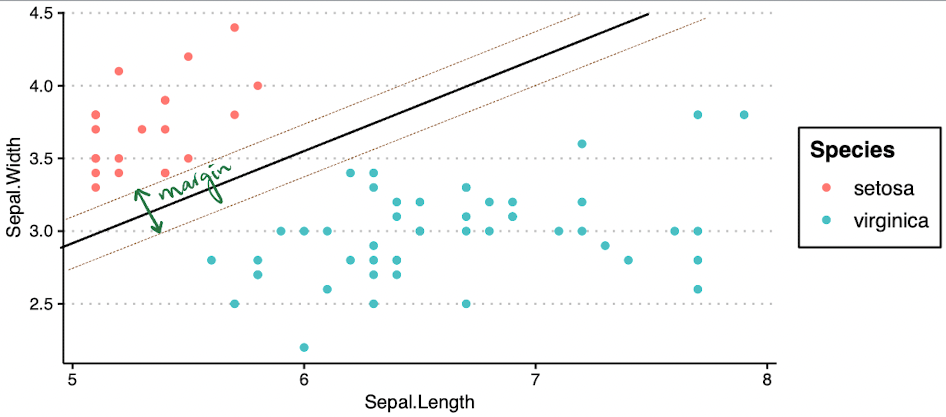
Option B
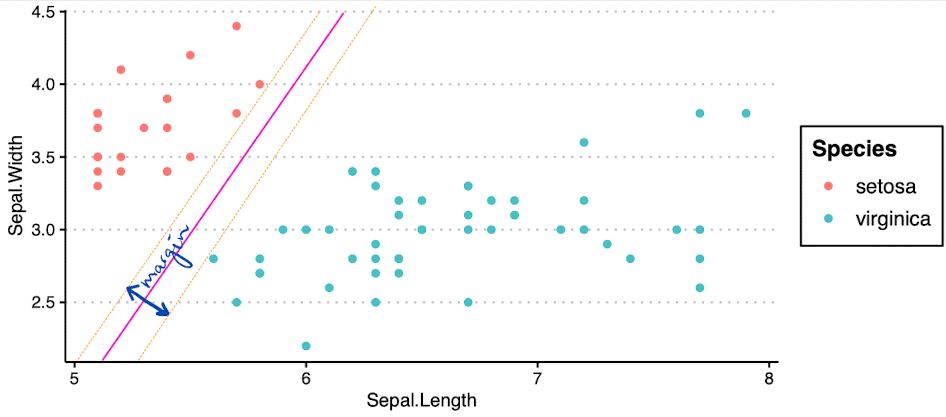
Option C
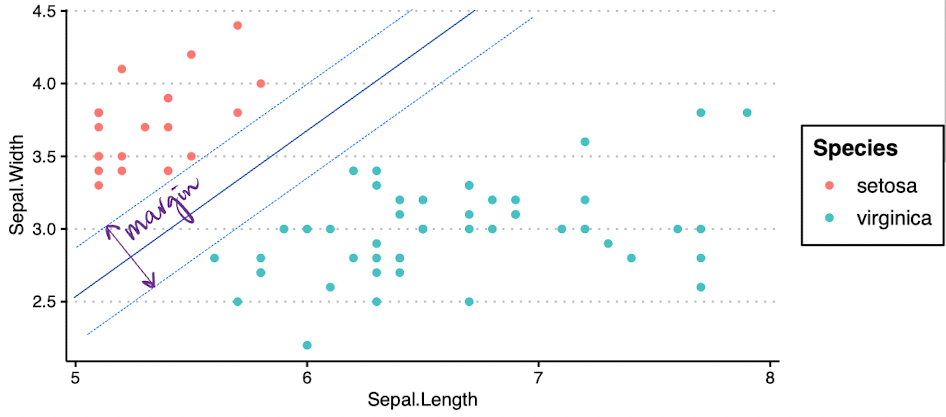
Mathematically…
The middle line of the margin is \(w'x + b = 0\) while the top and bottom lines are \(w'x + b = -1\) and \(w'x + b = 1\).
For any unseen point,
$$ f(x) = \begin{cases} 1 & \text{if} & w’x+b \geq 1 \ -1 & \text{if} &w’x + b \leq -1 \end{cases} $$
The margin width is \(\frac{2}{||w||^2}\), which has to maximized. This is equivalent to minimizing \(\frac{||w||^2}{2}\), subject to the constraints:
$$ f(x) = \begin{cases} 1 & \text{if} & w’x+b \geq 1 \ -1 & \text{if} &w’x + b \leq -1 \end{cases} $$
This is a constrained optimization problem that can be solved via many methods (numerical, quadratic optimization, etc.).
What if they’re not separable?
In our dummy example, I removed two points. But that is usually not a good idea. Can you exclude points from your data because they’re hard to classify?3
That’s a blunder for two reasons.
- First, we want to build a model that works for all data points — including extreme data points. We will not know if a test point is an extreme point.
- Second, how will you decide which points to remove? If you remove all tough cases, why even use SVM? A simple linear regression can do a reasonably good work forecasting some points.
Let’s take a look at a problem when the classes are not perfectly separable.
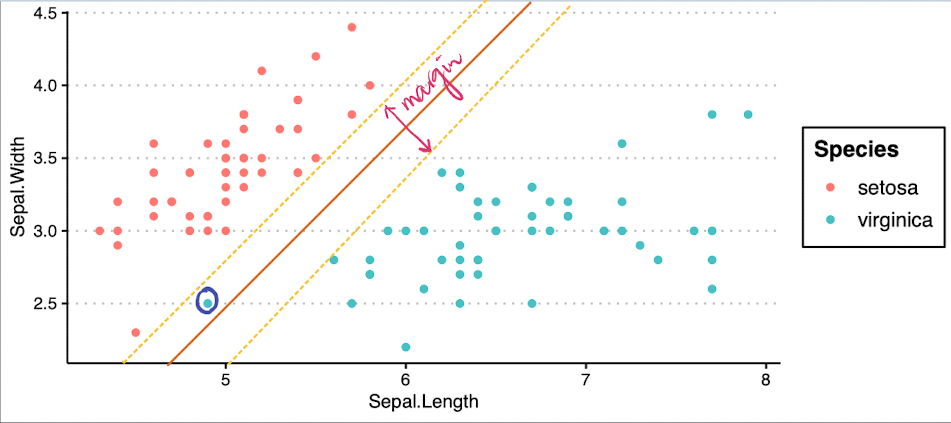
This one “blue” point is being misclassified. Can we do something about it?
Here come slack variables to rescue…
Slack variables ($\xi$) add a “padding” around the margin, which varies by observation. For data on the wrong side of the margin, the modified objective function’s value is proportional to its distance from the margin.
This is called “soft” margin.
Optimisation Problem
$$ \min L(w) = \frac{||w||^2}{2} + C\left( \sum_{i = 1}^N \xi_i^k \right) $$
subject to constraints
$$ f(x_i) = \begin{cases} 1 & \text{if} & w’x+b \geq 1 - \xi_i \ -1 & \text{if} &w’x + b \leq -1 + \xi_i \end{cases}. $$
Another alternative: Non-linear SVM
What if the data has a non-linear trend, like the example below? A linear hyperplane does not make sense at all in that case.
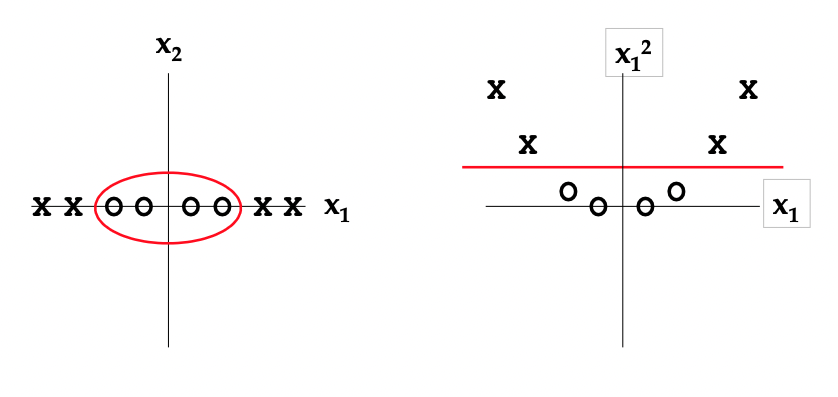
We can map our features to a new feature space where they are linearly separable. Recall that we usually take the natural logarithm of wealth before using them in linear regression. The concept is similar, except that it is very expansive and works for many cases.
Kernel Functions
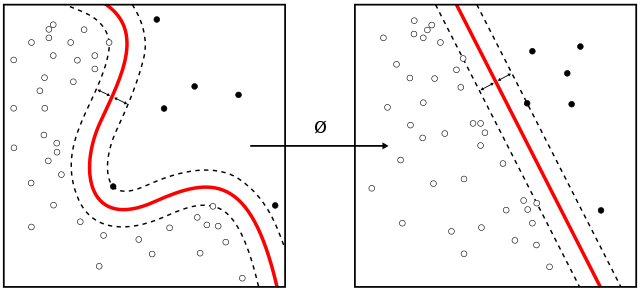
We can also create non-linear classifiers by applying “kernel trick”. It is a commonly known technique in statistics which converts lower-dimensional functions to higher-dimensional functions. Generally, it is easier to spot clear decision boundaries in higher dimensions.
The resulting algorithm is similar, except that a non-linear kernel function replaces every dot product. Then, the algorithm can fit the maximum-margin hyperplane in a transformed feature space.
Note that the transformation might be non-linear, and the new space can be high dimensional. The classifier will be a linear hyperplane in the new space but might be non-linear in the original input space.
Some Common Kernels
Polynomial Kernel
$$ k(x_i, x_j) = (x_i' x_j + 1)^d, $$
when \(d = 1\), this is linear kernel; \(d = 2\), this is quadratic kernel.
Radial Basis Kernel / Gaussian Kernel
$$ k(x_i, x_j) = \exp(-\gamma ||x_i - x_j||^2), $$
for all \(\gamma > 0\). When \(\gamma = 1/2\sigma^2\), this is known to have a width \(\sigma\). It is also known as Radial Basis Function (RBF).
Notes on SVM’s Practical Usage
- SVM performs best on average and can outperform most other techniques across many important applications.
- The effectiveness of SVM in practice depends on (a) the choice of kernel, (b) kernel’s parameters, and (c) soft-margin parameter
\(C\). - Gaussian Kernel (or RBF) is a common choice for kernel function. Its
\(\gamma\)has to be tuned. - Being a statistically-oriented method, the results are stable, reproducible and largely independent of the specific optimisation algorithm.
- Being a convex optimisation problem, this leads to the global optimum.
- Computational challenge: solving the optimisation problem has quadratic complexity. While this is not too bad, using Kernel spaces increases the number of features exaggerating the problem multifold.
- SVM classifier doesn’t provide posterior class probabilities like Logistic regression. It simply classifies the point into a region. Many packages estimate posterior probabilities with cross validation though.
Case Study: Classifying Type of Animals at a Zoo
In this example, we will try to predict the type of animal given it’s other characteristics using linear SVM, aka vanilla SVM. This is the zoo data from mlbench package.
Let’s see the data.
data(Zoo, package = "mlbench")
Zoo = as_tibble(Zoo)
Zoo |>
DT::datatable()
Correlation
Let’s do some descriptive statistics and explore how the data looks. How do different types of animals vary? Can we see a quick correlation?
library(ggcorrplot)
model.matrix(~0+., data = Zoo) |>
cor(use="pairwise.complete.obs") |>
ggcorrplot(show.diag = F, type="lower", lab=TRUE, lab_size=2)

This can tell us a lot of interesting insights!
Modelling
Fitting Model
But our time is limited, so jumping to SVM. Recall that train() takes formula as the first input, data as the second input, method as the third input and other training controls.
library(caret)
svmFit = train(
type ~.,
data = Zoo,
method = "svmLinear",
trControl = trainControl(method = "cv", number = 10)
)
svmFit
## Support Vector Machines with Linear Kernel
##
## 101 samples
## 16 predictor
## 7 classes: 'mammal', 'bird', 'reptile', 'fish', 'amphibian', 'insect', 'mollusc.et.al'
##
## No pre-processing
## Resampling: Cross-Validated (10 fold)
## Summary of sample sizes: 91, 90, 92, 89, 91, 92, ...
## Resampling results:
##
## Accuracy Kappa
## 0.97 0.9608681
##
## Tuning parameter 'C' was held constant at a value of 1
Let’s see details about the final model.
# storing final model
svmFinal = svmFit$finalModel
svmFinal
## Support Vector Machine object of class "ksvm"
##
## SV type: C-svc (classification)
## parameter : cost C = 1
##
## Linear (vanilla) kernel function.
##
## Number of Support Vectors : 47
##
## Objective Function Value : -0.1448 -0.218 -0.1484 -0.1754 -0.0936 -0.1033 -0.297 -0.0819 -0.1556 -0.0907 -0.1135 -0.182 -0.5763 -0.13 -0.1833 -0.118 -0.0474 -0.0823 -0.1236 -0.1481 -0.5666
## Training error : 0
Predictions
I will use predict() to calculate the predictions. I’m predicting on training data, which is not advisable. But it shows how the SVM function works.
# creating predictions
pred = predict(svmFit, newdata = Zoo)
pred
## [1] mammal mammal fish mammal mammal
## [6] mammal mammal fish fish mammal
## [11] mammal bird fish mollusc.et.al mollusc.et.al
## [16] mollusc.et.al bird mammal fish mammal
## [21] bird bird mammal bird insect
## [26] amphibian amphibian mammal mammal mammal
## [31] insect mammal mammal bird fish
## [36] mammal mammal bird fish insect
## [41] insect bird insect bird mammal
## [46] mammal mollusc.et.al mammal mammal mammal
## [51] mammal insect amphibian mollusc.et.al mammal
## [56] mammal bird bird bird bird
## [61] fish fish reptile mammal mammal
## [66] mammal mammal mammal mammal mammal
## [71] mammal bird mollusc.et.al fish mammal
## [76] mammal reptile mollusc.et.al bird bird
## [81] reptile mollusc.et.al fish bird mammal
## [86] mollusc.et.al fish bird insect amphibian
## [91] reptile reptile fish mammal mammal
## [96] bird mammal insect mammal mollusc.et.al
## [101] bird
## Levels: mammal bird reptile fish amphibian insect mollusc.et.al
Confusion Matrix
# confusion matrix
table(Zoo$type, pred)
## pred
## mammal bird reptile fish amphibian insect mollusc.et.al
## mammal 41 0 0 0 0 0 0
## bird 0 20 0 0 0 0 0
## reptile 0 0 5 0 0 0 0
## fish 0 0 0 13 0 0 0
## amphibian 0 0 0 0 4 0 0
## insect 0 0 0 0 0 8 0
## mollusc.et.al 0 0 0 0 0 0 10
Accuracy
The model has a 100% accuracy on the training data.
# prediction accuracy
sum(Zoo$type==pred)/nrow(Zoo)
## [1] 1
Post-notes
This article was originally created for my guest lecture in Prof Charles Liu’s BZAN 542: Data Mining Methods for Business Applications class. The lecture received positive response and interesting questions, which improved this document.
I would’ve preferred using Tidymodels’ SVM instead of caret. But since the entire class was designed with caret, I’ve followed the convention.
- Posted on:
- October 2, 2022
- Length:
- 10 minute read, 1991 words
- Categories:
- coding R statistics
- See Also: